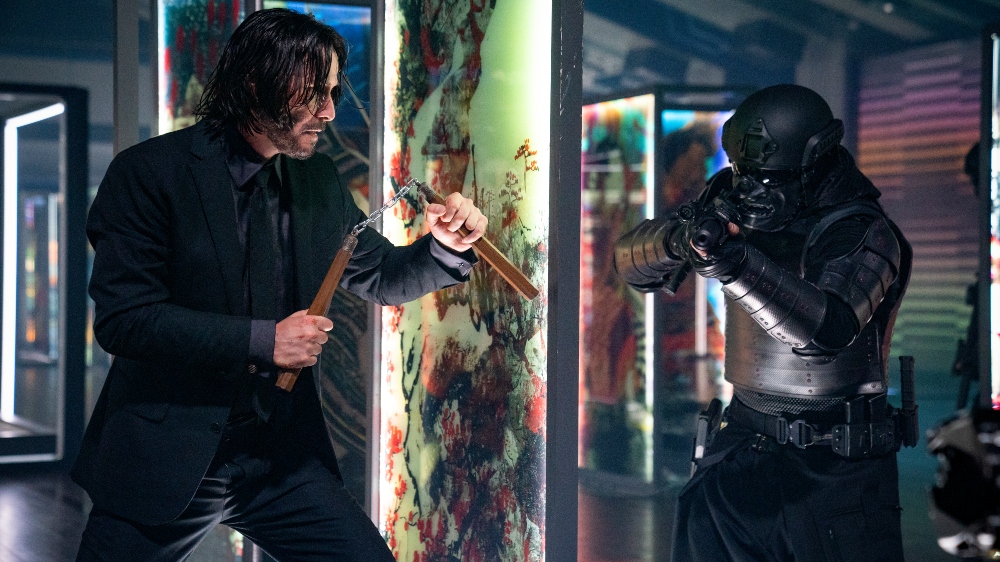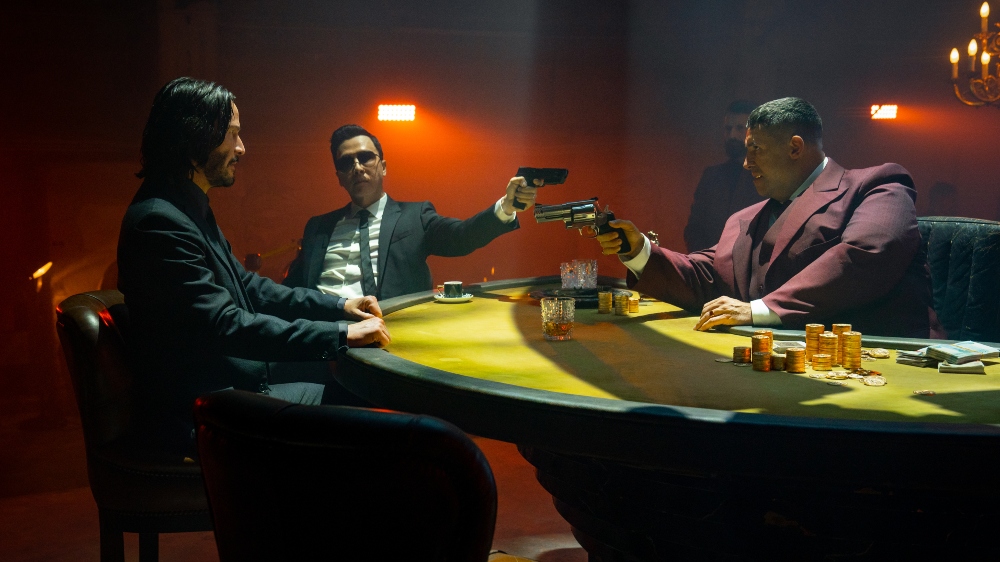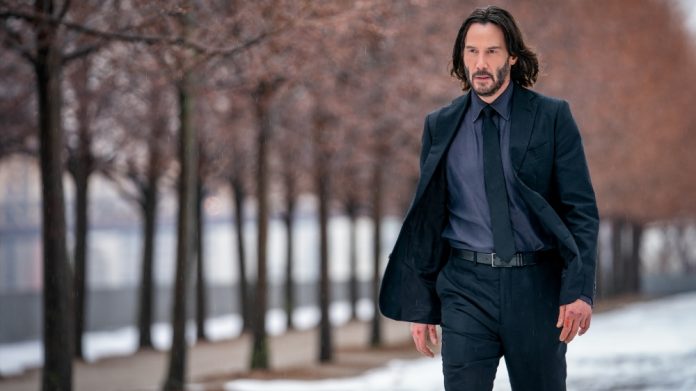In the world of John Wick, violence is choreographed with such beauty and momentum that it achieves glorious lyricism, ascending from mere action into a stylized bullet ballet in which fists fly, weapons find their marks, and bodies hit the floor with such a graceful, syncopated rhythm as to evoke the art of dance.
John Wick: Chapter 4, the latest and presumably last installment in the franchise, makes this link explicit during one of its many gorgeous, beat-driven set pieces, recalling the Red Circle bathhouse bloodshed of the first film. Keanu Reeves‘ titular hitman pursues a German criminal (martial arts star Scott Adkins) through a luxe Berlin nightclub, dispatching waves of henchmen as clubgoers continue to gyrate, occasionally glancing at Wick’s death blows as if comparing their moves to his. Rather than fleeing, they are unperturbed, acquiescent, attuned to the same fantasy physics and clandestine formalities that have governed this franchise since the start.
As Wick fights his way toward his quarry, death-dealing beneath flashing lights and overflowing water features that bathe the sequence in aesthetic signifiers of earthly transcendence, he is at once the aggrieved avenging angel that we first met almost a decade ago, in 2014’s John Wick, and something else: a world-class athlete in his element, putting on the show of a lifetime with the kind of impossible speed, skill, and discipline that marks these films most as miracles of kinetic pop artistry. At one point, the Marquis de Gramont (a sneering Bill Skarsgård), Chapter 4’s newly appointed archvillain, remarks to Wick, “It’s the killing that gives you purpose,” as plainly logical an observation as one could make of John Wick, and of John Wick, but also a dismissal of the spectacularly aerobic ingenuity that arms and armors this professional at work, that propels these movies into the upper echelons of the modern action cinema. The killing might give him purpose, but it’s the movement that brings it meaning.
Orchestrated flawlessly throughout its sprawling 169 minutes, Chapter 4 succeeds in surpassing its predecessors by giving audiences bigger, better action than that on display in the previous installments, themselves successively bar-raising spectacles that now represent a new class of action blockbuster. The film’s setpieces, which unfold on a world stage, are classically structured and impeccably shot, each establishing dramatic tension and an opulent sense of space before weaponizing both attributes in a mad race toward a dramatic, cathartic climax.

Opening with a horse chase across the sands of Morocco that evokes Lawrence of Arabia in more than just its epic scale, Chapter 4 then surges from New York to Osaka to Berlin to Paris, finding in these locales open playgrounds for both carnage and homage — to great film artists as distinguished as Zhang Yimou, Jet Li, Akira Kurosawa, Sergio Leone, Clint Eastwood, John Woo, Shintaro Katsu, Sammo Hung, Jackie Chan, Yuen Biao, Yuen Woo-ping, Walter Hill, and Jean-Pierre Melville, but also to iconic works of Renaissance art and classical architecture — all generously reflected through the John Wick series’ abstracted-urbanity aesthetic (thrillingly realized by production designer Kevin Kavanaugh and cinematographer Dan Lausten) but enabled by its ever-deepening mythology and correspondingly expansive capacity to synthesize inspirations.
As the architect — or, perhaps more aptly, the ringmaster — of the John Wick franchise, returning director Chad Stahelski proves himself an unparalleled master of controlled chaos, the ambitious precision and astonishing cohesion of his vision for the film’s action sequences allowing each to thrill individually while adding to the series’ sense of relentless, game-like progression. One incendiary set piece in a French apartment building, during which Wick wields a “dragon’s-breath shotgun” against hordes of assassins, appears to play out as a one-shot gunfight thanks to dramatic overhead framing that provides a god’s-eye view of the mayhem. Another semi-comic sequence, in which Wick battles up the stairs of the Sacré-Coeur, adds Sisyphus to the litany of Greek myths that the character has embodied throughout the franchise (also see: Odysseus, fatefully adrift from his beloved wife, and Orpheus, seeking to climb out of the underworld, and a slapstick battle royale at the Arc de Triomphe is a Goldbergian collision of cars, guns, bikes, and bodies that puts to shame the theatrics in Tom Cruise‘s more impersonal Mission: Impossible – Fallout.
The unsustainable excess of this fourth chapter, and the kind of fatigue by over-stimulation that can creep in besides such sustained bloodsport, is precisely its point. Even as the world around Wick expands, and the death count spikes exponentially, Chapter 4 remembers well that the body keeps the score, and Reeves — one of our most sincere leading men, a paragon of gentle humanity and decency in between beating his adversaries senseless with a pair of nunchucks — makes the weariness of this long-anguished assassin more palpable than ever. We recall where this all started, that Wick’s one-man war on everyone is an act of justifiable self-defense.

In the franchise’s florid, admittedly top-heavy lore, complete with an unseen High Table that pulls rank on all the assassins who operate under it and frequent invocations of arcane Latin phrases, the one rule that governs all is that simple fact of mortality: that all men must die. As such, Chapter 4 is the most emotionally affecting of the John Wick films, with a near-operatic sense of finality and weight. (The role of hotel concierge Charon is once more played by Lance Reddick, who died earlier this month, and knowledge of the actor’s passing amplifies the sense of melancholy that would have already pervaded Chapter 4; his first appearance on screen was greeted with sustained applause in my screening, his final scene met with astonished tears.)
The existential sorrow of John Wick, a man who’s known death for far too long and seen it take the lives of people he has valued, drives the film forward — toward a pistols-at-dawn showdown that distills the franchise’s stakes to the path of a single bullet — and backward, during the aforementioned nightclub sequence and through the introduction of new characters (Donnie Yen, as a Zatoichi-esque blind assassin; Rina Sawayama, as a concierge at the Osaka Continental; and Shamier Anderson, as the pragmatic Tracker) whose uniquely aggrieved codes of honor align them with John while reminding us of his spiritual burdens. Amid such introspective moments arrive opportunities for redemption, wrongs that John can right even as the cost of doing so compounds his exhaustion. He even saves a dog.
To invoke another of Reeves’ seminal action franchises, every character in the John Wick franchise believes that they are The One. Inevitably, John proves every last one of them wrong. As legendary a figure in their secret world order as Jesus Christ is in ours, his violence is a cleansing force of truth in an underworld made arrogant by its enduring lethality and power. His bullets spread the good word to those who think themselves above it. To his cabal of assassins, the art of war is religion — a grandiloquent concept that the unpretentious brutality of the series’ fights seek to off-set, not undermine — but death yet awaits even the most elite among them. In carrying John Wick through one last battle, Chapter 4 lays the franchise to rest with a viscerally, deliriously hyper-active extravaganza, sticking to its guns and brandishing its style but achieving also a triumphant parting grandeur that marks this franchise as a model work of action-cinema mythology.
Grade: A
John Wick: Chapter 4 is now playing in theaters nationwide courtesy of Lionsgate.



